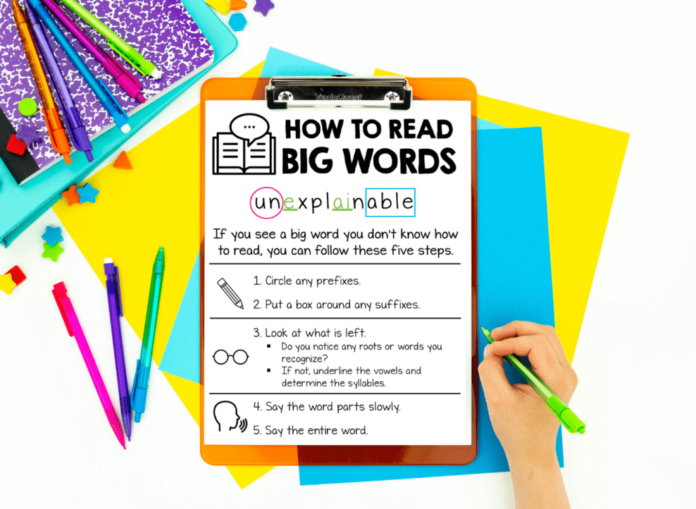
Breaking Down Barriers: How to Teach Multisyllabic Words Successfully
Teaching multisyllabic words can be a challenging task for educators, as it requires breaking down words into smaller, more manageable parts for students to comprehend and pronounce. However, breaking down barriers in teaching multisyllabic words is crucial for students to develop strong literacy skills and improve their overall reading proficiency. In this article, we will discuss several strategies for teaching multisyllabic words successfully, and how educators can effectively break down barriers for their students.
Understanding Multisyllabic Words
Before diving into the strategies for teaching multisyllabic words, it’s essential to understand what multisyllabic words are. Multisyllabic words are words that contain more than one syllable, making them longer and more complex to read and pronounce. Examples of multisyllabic words include “elephant,” “umbrella,” and “chocolate.” For students, recognizing and decoding multisyllabic words can be particularly challenging, as they often require the ability to identify and pronounce each syllable accurately.
The Challenge of Teaching Multisyllabic Words
Teaching multisyllabic words presents several challenges for educators. Many students struggle with breaking down longer words into smaller parts, which can hinder their reading fluency and comprehension. When faced with multisyllabic words, students may feel overwhelmed and discouraged, leading to a lack of confidence in their reading abilities. Additionally, English language learners and students with learning disabilities may face even greater difficulties in mastering multisyllabic words.
Strategies for Teaching Multisyllabic Words Successfully
To overcome these challenges and break down barriers in teaching multisyllabic words, educators can implement several effective strategies. By incorporating these strategies into their instruction, educators can help students develop the skills and confidence needed to tackle multisyllabic words with ease.
1. Teach syllabication rules: One of the first steps in teaching multisyllabic words is to introduce students to syllabication rules. By understanding how to divide words into syllables, students can more effectively decode and pronounce multisyllabic words. Educators can teach students common syllabication rules, such as identifying vowel sounds, recognizing consonant blends, and understanding word patterns.
2. Use word parts: Breaking down multisyllabic words into smaller word parts can make them less intimidating for students. Educators can teach students to identify prefixes, suffixes, and root words within multisyllabic words, helping them recognize familiar word parts and understand the meanings of complex words. Using word parts as a strategy can also improve students’ vocabulary skills and comprehension.
3. Provide visual aids: Visual aids, such as word cards, charts, and diagrams, can help students visualize multisyllabic words and their individual syllables. Educators can create visual aids that showcase the syllables of various words, allowing students to see and manipulate the word parts. Visual aids can also be used to highlight common word patterns and phonetic rules, making it easier for students to decode multisyllabic words.
4. Model and practice: Modeling the process of breaking down multisyllabic words and providing ample opportunities for practice are essential for students to master this skill. Educators can demonstrate how to decode a multisyllabic word by identifying its syllables and sounding them out. Additionally, providing activities and exercises that require students to practice decoding multisyllabic words can reinforce their skills and boost their confidence.
5. Offer word lists and resources: Providing students with word lists and resources containing multisyllabic words can help them practice decoding and pronouncing these words independently. Educators can create word lists that include multisyllabic words with varying difficulty levels, allowing students to work at their own pace. Additionally, online resources and apps that focus on multisyllabic words can provide students with interactive learning opportunities.
Breaking Down Barriers in Teaching Multisyllabic Words
By incorporating these strategies into their instruction, educators can effectively break down barriers in teaching multisyllabic words. These strategies provide students with the tools and support they need to master the skills required to tackle multisyllabic words with confidence. By understanding syllabication rules, using word parts, providing visual aids, modeling and practicing, and offering word lists and resources, educators can empower their students to become proficient readers and overcome the challenges of multisyllabic words.
In conclusion, teaching multisyllabic words successfully requires educators to implement effective strategies that break down barriers for students. By providing students with the tools, support, and opportunities to practice and master the skills needed to decode multisyllabic words, educators can help their students develop strong literacy skills and improve their overall reading proficiency. Through effective instruction and targeted strategies, educators can empower their students to conquer the challenge of multisyllabic words and become confident, proficient readers.


















